1 of 20
Download to read offline
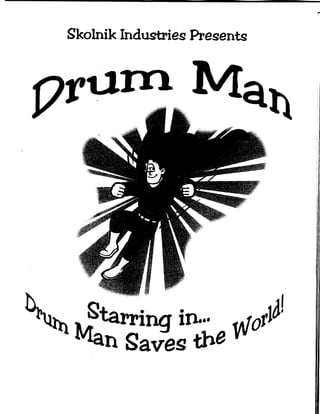
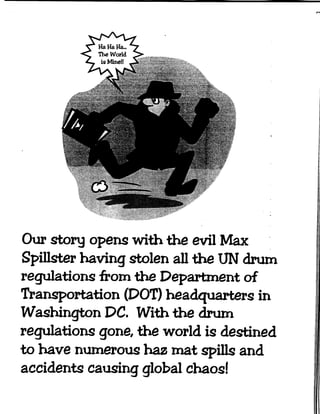




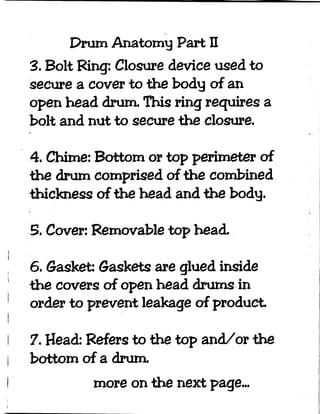

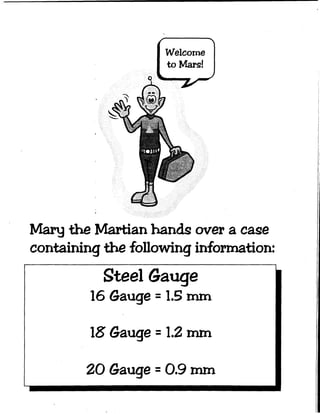
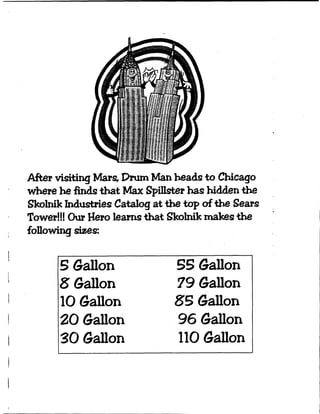


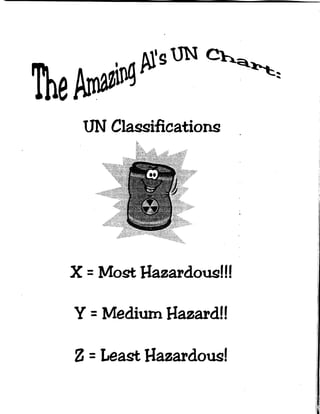
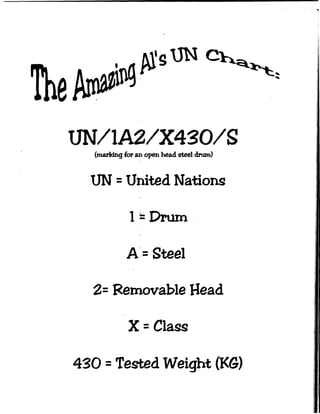
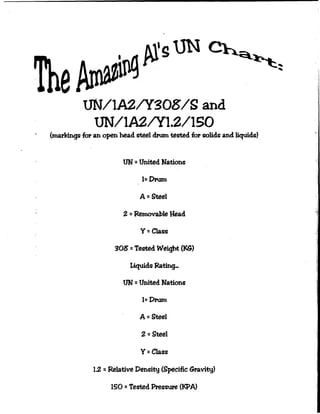
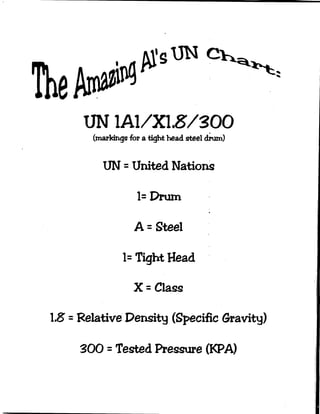
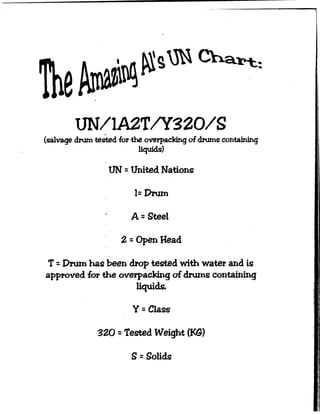
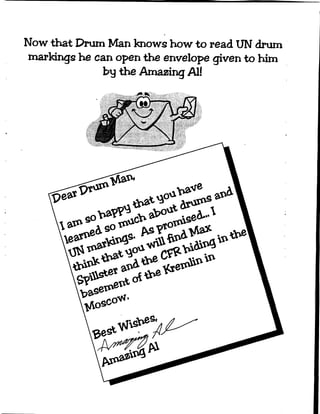
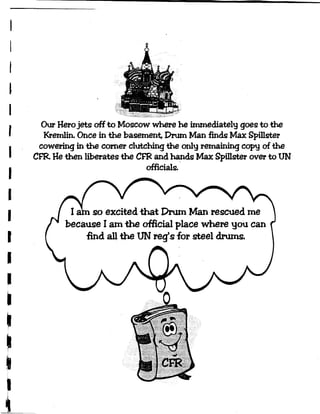
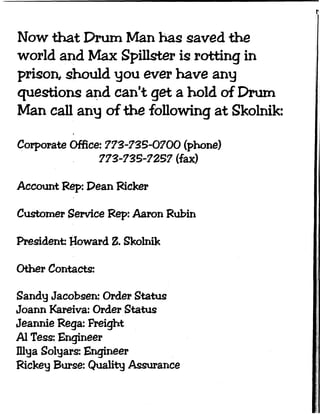
Ad
Recommended
Hazmat Awareness 08
Hazmat Awareness 08HZSkolnik
?
The document educates elementary and high school students about hazardous materials found in everyday products and their potential dangers. It encourages awareness and proactive behavior, such as reporting suspicious items, while also highlighting career opportunities in the hazmat field. Resources for further education and general safety practices are provided to empower students to act as 'hazmat heroes'.Dgis dangerous goods instructors symposium 2013
Dgis dangerous goods instructors symposium 2013HZSkolnik
?
Hazardous materials packagings have been regulated in the US since the early 1900s, originally by the Bureau of Explosives and later the DOT. Over time, regulations have consolidated and expanded to include stringent testing requirements for "specification" packagings. Today PHMSA regulates packaging under international standards. The document discusses the history of regulations and an industrial packaging manufacturer's testing process to comply with DOT certification standards.Dgr for crewmember 2016 recurrent
Dgr for crewmember 2016 recurrenttravira
?
This document provides an overview of dangerous goods regulations for transportation by air. It outlines the objectives of dangerous goods training which include identifying dangerous goods and their classes, understanding regulations and philosophy, recognizing labels, and emergency response procedures. It then details the 9 classes of dangerous goods and their divisions and hazards. The document emphasizes that the shipper bears primary responsibility for classifying, packing, marking and documenting dangerous goods in accordance with regulations. It explains that key documents for transporting dangerous goods include the shipper's declaration, notification to the pilot, and material safety data sheets.Dangerous Goods
Dangerous Goodsadi sinta nurjanah
?
Dokumen ini menjelaskan prosedur petugas check-in di bandara terkait barang berbahaya yang dibawa penumpang, mengidentifikasi berbagai jenis barang yang dilarang atau dapat diterima dengan syarat tertentu. Barang berbahaya seperti bahan mudah terbakar, bahan peledak, dan zat korosif memerlukan pemahaman dan kepatuhan terhadap peraturan keamanan. Penumpang diimbau untuk melaporkan barang yang akan dibawa agar perjalanan lancar dan aman.Dangerous goods
Dangerous goodskevc8903
?
The dangerous goods regulations classify dangerous items into 9 categories and exist to ensure safety on flights. They prohibit lithium batteries, fireworks, disabling devices, and any irritating or incapacitating substances in carry-on or checked bags. Unacceptable hand baggage items include non-safety matches, normal lighters beyond one per passenger, helium balloons, inflated balls, laser pointers, knitting needles, paint, gas-heated curling irons beyond one per passenger, and liquids over certain sizes due to fire and explosion risks that could endanger the aircraft.Top 10 Things You Didn°Øt Know About Dangerous Goods
Top 10 Things You Didn°Øt Know About Dangerous GoodsLabelmaster
?
The document discusses the complexities of shipping dangerous goods and the importance of compliance with evolving regulations. It highlights various items that may fall under the dangerous goods category, the significant number of shipments involving such goods, and the potential fines for non-compliance. The e-book aims to educate shippers about these regulations to ensure safety and prevent penalties.Dangerous Goods Training- awareness
Dangerous Goods Training- awarenessMowaffak Breighesh
?
This document provides an overview of dangerous goods regulations. It defines key organizations like IATA and key terms like overpack. It describes shipper and operator responsibilities. Nine hazard classes are described including examples like explosives, gases, and corrosives. Proper packaging, marking, labeling and documentation like the shipper's declaration are outlined. Classification identifies the hazard and packing group. Regulations cover packing methods, UN codes, and permitted dangerous goods on passengers.Waste management 2014 challenges in manufacturing of ram packages (revision...
Waste management 2014 challenges in manufacturing of ram packages (revision...HZSkolnik
?
Howard Z. Skolnik, President of Waste Management, gave a presentation at the Waste Management Symposium in Phoenix on March 4th, 2014. He discussed the challenges his company faces in manufacturing steel drums for low-level nuclear waste, including the costs of complying with nuclear quality assurance programs without long-term commitments from Department of Energy contractors, differing requirements between sites, and excessive auditing and testing requirements. He suggested improvements such as accepting audits universally between sites, using common specifications, considering costs when making requests, and establishing a vendor recourse procedure.New Venture Lab 2013
New Venture Lab 2013HZSkolnik
?
The document discusses Skolnik, a company that manufactures industrial packaging drums. It provides an overview of the company and the industrial packaging industry. Skolnik offers over 150 UN certifications and customized drum solutions. They are a world leader in salvage drums and focus on compliance. Their drum types include carbon steel, stainless steel, and a new seamless stainless steel drum. The presentation discusses expanding into higher margin stainless steel and seamless steel drums that are used in pharmaceutical, specialty chemicals, food processing, and personal care industries. It provides objectives for a class project to investigate the stainless steel and seamless steel drum market opportunities and recommend go-to-market strategies for Skolnik.Illinois energy efficiency expo 2013
Illinois energy efficiency expo 2013HZSkolnik
?
Howard Skolnik, President and CEO of Skolnik Industries, will be attending the 2013 Illinois Energy Efficiency Expo on September 10, 2013. The expo will showcase energy efficient technologies and solutions. Skolnik Industries' website is www.skolnik.com.Peter mackay dgis 2012
Peter mackay dgis 2012HZSkolnik
?
This document lists several major industrial accidents and disasters over the years involving hazardous cargo and chemicals. It notes common themes in why these accidents occurred, such as taking shortcuts, commercial pressure, and lack of or ineffective training, which often led to a failure to follow proper procedures. The document emphasizes that in high-hazard environments, any operation can be safety-critical, so clear written procedures, checklists as reminders rather than just box-ticking, and thorough training are needed to reinforce safe practices.Icao competency frameworks 2012 by geoff leach
Icao competency frameworks 2012 by geoff leachHZSkolnik
?
The document summarizes ICAO's work program for 2012-13, focusing on competency frameworks, cooperation with security colleagues, NOTOC (Notification to Captain), and lithium batteries. Key points include ICAO moving towards competency-based training for various personnel, including dangerous goods shippers and handlers. A competency framework includes competency units, elements, and performance criteria. Cooperation opportunities between dangerous goods and security staff are also discussed.DDIS 11-28-07 by Dean
DDIS 11-28-07 by DeanHZSkolnik
?
The document discusses steel drum packaging standards according to the Code of Federal Regulations. It provides statistics on steel drum production and market share. It outlines the tests and requirements for Type A packaging for radioactive materials, including drop tests, penetration tests, and water spray tests. It also discusses requirements for nitric acid drums, salvage drums, closure instructions, and the reuse of salvage drums. Thinning of steel drums over time is identified as an issue that can prevent reuse and lead to integrity issues.Writing Closure Instructions(3) 2011
Writing Closure Instructions(3) 2011HZSkolnik
?
The document outlines requirements for notifying recipients of packaging transfers about compliance with regulations, including information on closures and components needed to pass performance tests. It also requires documenting procedures for assembly, closure instructions, and pressure differential guidance. Test reports must be prepared after qualification and retention tests, maintained where packaging is produced and tested for two years, and made available to users or regulators upon request. Reports must include facility information, packaging details, test descriptions and results.Partnership of Public Service with DOT
Partnership of Public Service with DOTHZSkolnik
?
Skolnik is an independently owned small business that has been operating since 1985. They manufacture steel containers for safely transporting and disposing of hazardous materials. To manage global compliance issues as a small business, Skolnik has established a compliance coalition that includes collaborating with employee benefits and human resources partners, industry groups, and participating in domestic and international regulatory bodies. The compliance coalition allows Skolnik to stay up to date on regulations and share resources, as managing these issues used to require a whole village but now takes collaboration across a whole country.Drum school 102 rev 1
Drum school 102 rev 1HZSkolnik
?
The document outlines the 18 step process for manufacturing steel drums from acquiring raw materials through stamping, forming, welding, painting parts, assembling the drum bodies, testing the welds, lining the interiors, packaging, and UN testing the final drums. Key steps include stamping parts, forming and welding drum bodies, expanding hoops, lining and curing drum interiors, final testing and packaging before UN certification.Seamless stainless construction 3 2010
Seamless stainless construction 3 2010HZSkolnik
?
The document summarizes the process for constructing seamless stainless steel nitric acid packaging drums. It involves welding stainless steel sheets to form the drum body, passivating welds to remove carbon discoloration, adding reinforcement bars and other components, leak testing, passivating the interior with a citric acid solution to remove any remaining carbon, drying, and preparing the finished drum for shipping by adding labels and packaging.Seamless stainless construction mc master 11-2010
Seamless stainless construction mc master 11-2010HZSkolnik
?
The document describes the process for constructing seamless stainless steel nitric packaging drums for McMaster-Carr. The process involves welding stainless steel sheets into drums, passivating welds to remove discoloration, testing for leaks, passivating the interior through rotation in a citric solution, drying, labeling, and packaging the drums for shipment.SI question presentation mar98
SI question presentation mar98HZSkolnik
?
The document is a 10 question true/false quiz about Skolnik Industries, a manufacturer of steel salvage drums and overpacks. It covers details like the materials used, shipping times, minimum order quantities, closure instructions, and testing standards. The overall goal is for the reader to learn about Skolnik's products and services.Dangerous Goods Symposium 11 28-07
Dangerous Goods Symposium 11 28-07HZSkolnik
?
The document discusses steel drum packaging standards according to the Code of Federal Regulations. It provides statistics on steel drum production and market share. It outlines the tests and requirements for Type A packaging for radioactive materials, as well as thickness requirements for nitric acid drums. Salvage drums must be compatible with their contents and pass leakproofness tests. Reused salvage drums must maintain integrity and be marked appropriately. Using identical replacement parts on drums is important. Thinning drum steel can lead to drums no longer meeting standards and increased failure risks.DOE Presentation for CTMA 06-07 - Script
DOE Presentation for CTMA 06-07 - ScriptHZSkolnik
?
This document summarizes a presentation given to the CTMA on June 4th, 2007 regarding packaging headaches related to steel drums. The presentation covers steel drum design criteria, relevant regulatory issues, and how DOE quality requirements can sometimes cause headaches for both the DOE and their vendors. Key points include: 1) Global trends have reduced steel drum wall thicknesses, affecting protection levels. 2) Regulatory changes to closure instructions and markings have made compliance more difficult. 3) Inconsistent requirements between the DOE and vendors can lead to challenges in meeting all standards.Reverse Logistics1.30.2008
Reverse Logistics1.30.2008HZSkolnik
?
The document discusses reverse logistics and the transportation of hazardous materials being returned. It defines reverse logistics as the return of purchased goods and examines who receives the returns and why items are returned. The document outlines that transportation of returns is regulated and how the process of reverse logistics works from preparation to transport. It describes COSTHA's role in partnering with the DOT to develop standards and guidelines to enhance safety in transporting hazardous reverse logistics goods.www Dot Packaging 2002
www Dot Packaging 2002HZSkolnik
?
The document discusses changes to packaging security regulations pre- and post-9/11. It outlines new regulatory bodies and affected packaging types. It also provides recommendations for securing shipments, including performing classification and closure procedures correctly, using tamper-proof seals, and considering multi-life tracking programs. Asset tracking from production to disposal is presented as the next technology wave for monitoring package locations and statuses.Drum School 101 Powerpoint
Drum School 101 PowerpointHZSkolnik
?
An introduction to understanding UN/DOT certified steel drum requirements for the shipment of dangerous goods.Closure Instructions Labelmaster Sept 2009
Closure Instructions Labelmaster Sept 2009HZSkolnik
?
The document summarizes key points from a symposium on properly closing steel drums in accordance with regulations for shipping hazardous materials:
1) Shippers are responsible for following closure instructions to ensure drums are properly sealed to prevent leaks during transport.
2) Closure instructions have become more standardized but must match the manufacturer's specifications and be kept up to date.
3) Shippers should check that drums are properly torqued and dimensions meet requirements before shipping, and should contact manufacturers if drums cannot be safely closed or sealed.Microwatt: Open Tiny Core, Big Possibilities
Microwatt: Open Tiny Core, Big PossibilitiesIBM
?
Microwatt is a lightweight, open-source core based on the OpenPOWER ISA.
It°Øs designed for FPGAs and easy experimentation in chip design.
Ideal for education, prototyping, and custom silicon development.
Fully open, it empowers developers to learn, modify, and innovate.Introduction to Natural Language Processing - Stages in NLP Pipeline, Challen...
Introduction to Natural Language Processing - Stages in NLP Pipeline, Challen...resming1
?
Lecture delivered in 2021. This gives an introduction to Natural Language Processing. It describes the use cases of NLP in daily life. It discusses the stages in NLP Pipeline. It highlights the challenges involved covering the different levels of ambiguity that could arise. It also gives a brief note on the present scenario with the latest language models, tools and frameworks/libraries for NLP.More Related Content
More from HZSkolnik (20)
Waste management 2014 challenges in manufacturing of ram packages (revision...
Waste management 2014 challenges in manufacturing of ram packages (revision...HZSkolnik
?
Howard Z. Skolnik, President of Waste Management, gave a presentation at the Waste Management Symposium in Phoenix on March 4th, 2014. He discussed the challenges his company faces in manufacturing steel drums for low-level nuclear waste, including the costs of complying with nuclear quality assurance programs without long-term commitments from Department of Energy contractors, differing requirements between sites, and excessive auditing and testing requirements. He suggested improvements such as accepting audits universally between sites, using common specifications, considering costs when making requests, and establishing a vendor recourse procedure.New Venture Lab 2013
New Venture Lab 2013HZSkolnik
?
The document discusses Skolnik, a company that manufactures industrial packaging drums. It provides an overview of the company and the industrial packaging industry. Skolnik offers over 150 UN certifications and customized drum solutions. They are a world leader in salvage drums and focus on compliance. Their drum types include carbon steel, stainless steel, and a new seamless stainless steel drum. The presentation discusses expanding into higher margin stainless steel and seamless steel drums that are used in pharmaceutical, specialty chemicals, food processing, and personal care industries. It provides objectives for a class project to investigate the stainless steel and seamless steel drum market opportunities and recommend go-to-market strategies for Skolnik.Illinois energy efficiency expo 2013
Illinois energy efficiency expo 2013HZSkolnik
?
Howard Skolnik, President and CEO of Skolnik Industries, will be attending the 2013 Illinois Energy Efficiency Expo on September 10, 2013. The expo will showcase energy efficient technologies and solutions. Skolnik Industries' website is www.skolnik.com.Peter mackay dgis 2012
Peter mackay dgis 2012HZSkolnik
?
This document lists several major industrial accidents and disasters over the years involving hazardous cargo and chemicals. It notes common themes in why these accidents occurred, such as taking shortcuts, commercial pressure, and lack of or ineffective training, which often led to a failure to follow proper procedures. The document emphasizes that in high-hazard environments, any operation can be safety-critical, so clear written procedures, checklists as reminders rather than just box-ticking, and thorough training are needed to reinforce safe practices.Icao competency frameworks 2012 by geoff leach
Icao competency frameworks 2012 by geoff leachHZSkolnik
?
The document summarizes ICAO's work program for 2012-13, focusing on competency frameworks, cooperation with security colleagues, NOTOC (Notification to Captain), and lithium batteries. Key points include ICAO moving towards competency-based training for various personnel, including dangerous goods shippers and handlers. A competency framework includes competency units, elements, and performance criteria. Cooperation opportunities between dangerous goods and security staff are also discussed.DDIS 11-28-07 by Dean
DDIS 11-28-07 by DeanHZSkolnik
?
The document discusses steel drum packaging standards according to the Code of Federal Regulations. It provides statistics on steel drum production and market share. It outlines the tests and requirements for Type A packaging for radioactive materials, including drop tests, penetration tests, and water spray tests. It also discusses requirements for nitric acid drums, salvage drums, closure instructions, and the reuse of salvage drums. Thinning of steel drums over time is identified as an issue that can prevent reuse and lead to integrity issues.Writing Closure Instructions(3) 2011
Writing Closure Instructions(3) 2011HZSkolnik
?
The document outlines requirements for notifying recipients of packaging transfers about compliance with regulations, including information on closures and components needed to pass performance tests. It also requires documenting procedures for assembly, closure instructions, and pressure differential guidance. Test reports must be prepared after qualification and retention tests, maintained where packaging is produced and tested for two years, and made available to users or regulators upon request. Reports must include facility information, packaging details, test descriptions and results.Partnership of Public Service with DOT
Partnership of Public Service with DOTHZSkolnik
?
Skolnik is an independently owned small business that has been operating since 1985. They manufacture steel containers for safely transporting and disposing of hazardous materials. To manage global compliance issues as a small business, Skolnik has established a compliance coalition that includes collaborating with employee benefits and human resources partners, industry groups, and participating in domestic and international regulatory bodies. The compliance coalition allows Skolnik to stay up to date on regulations and share resources, as managing these issues used to require a whole village but now takes collaboration across a whole country.Drum school 102 rev 1
Drum school 102 rev 1HZSkolnik
?
The document outlines the 18 step process for manufacturing steel drums from acquiring raw materials through stamping, forming, welding, painting parts, assembling the drum bodies, testing the welds, lining the interiors, packaging, and UN testing the final drums. Key steps include stamping parts, forming and welding drum bodies, expanding hoops, lining and curing drum interiors, final testing and packaging before UN certification.Seamless stainless construction 3 2010
Seamless stainless construction 3 2010HZSkolnik
?
The document summarizes the process for constructing seamless stainless steel nitric acid packaging drums. It involves welding stainless steel sheets to form the drum body, passivating welds to remove carbon discoloration, adding reinforcement bars and other components, leak testing, passivating the interior with a citric acid solution to remove any remaining carbon, drying, and preparing the finished drum for shipping by adding labels and packaging.Seamless stainless construction mc master 11-2010
Seamless stainless construction mc master 11-2010HZSkolnik
?
The document describes the process for constructing seamless stainless steel nitric packaging drums for McMaster-Carr. The process involves welding stainless steel sheets into drums, passivating welds to remove discoloration, testing for leaks, passivating the interior through rotation in a citric solution, drying, labeling, and packaging the drums for shipment.SI question presentation mar98
SI question presentation mar98HZSkolnik
?
The document is a 10 question true/false quiz about Skolnik Industries, a manufacturer of steel salvage drums and overpacks. It covers details like the materials used, shipping times, minimum order quantities, closure instructions, and testing standards. The overall goal is for the reader to learn about Skolnik's products and services.Dangerous Goods Symposium 11 28-07
Dangerous Goods Symposium 11 28-07HZSkolnik
?
The document discusses steel drum packaging standards according to the Code of Federal Regulations. It provides statistics on steel drum production and market share. It outlines the tests and requirements for Type A packaging for radioactive materials, as well as thickness requirements for nitric acid drums. Salvage drums must be compatible with their contents and pass leakproofness tests. Reused salvage drums must maintain integrity and be marked appropriately. Using identical replacement parts on drums is important. Thinning drum steel can lead to drums no longer meeting standards and increased failure risks.DOE Presentation for CTMA 06-07 - Script
DOE Presentation for CTMA 06-07 - ScriptHZSkolnik
?
This document summarizes a presentation given to the CTMA on June 4th, 2007 regarding packaging headaches related to steel drums. The presentation covers steel drum design criteria, relevant regulatory issues, and how DOE quality requirements can sometimes cause headaches for both the DOE and their vendors. Key points include: 1) Global trends have reduced steel drum wall thicknesses, affecting protection levels. 2) Regulatory changes to closure instructions and markings have made compliance more difficult. 3) Inconsistent requirements between the DOE and vendors can lead to challenges in meeting all standards.Reverse Logistics1.30.2008
Reverse Logistics1.30.2008HZSkolnik
?
The document discusses reverse logistics and the transportation of hazardous materials being returned. It defines reverse logistics as the return of purchased goods and examines who receives the returns and why items are returned. The document outlines that transportation of returns is regulated and how the process of reverse logistics works from preparation to transport. It describes COSTHA's role in partnering with the DOT to develop standards and guidelines to enhance safety in transporting hazardous reverse logistics goods.www Dot Packaging 2002
www Dot Packaging 2002HZSkolnik
?
The document discusses changes to packaging security regulations pre- and post-9/11. It outlines new regulatory bodies and affected packaging types. It also provides recommendations for securing shipments, including performing classification and closure procedures correctly, using tamper-proof seals, and considering multi-life tracking programs. Asset tracking from production to disposal is presented as the next technology wave for monitoring package locations and statuses.Drum School 101 Powerpoint
Drum School 101 PowerpointHZSkolnik
?
An introduction to understanding UN/DOT certified steel drum requirements for the shipment of dangerous goods.Closure Instructions Labelmaster Sept 2009
Closure Instructions Labelmaster Sept 2009HZSkolnik
?
The document summarizes key points from a symposium on properly closing steel drums in accordance with regulations for shipping hazardous materials:
1) Shippers are responsible for following closure instructions to ensure drums are properly sealed to prevent leaks during transport.
2) Closure instructions have become more standardized but must match the manufacturer's specifications and be kept up to date.
3) Shippers should check that drums are properly torqued and dimensions meet requirements before shipping, and should contact manufacturers if drums cannot be safely closed or sealed.Recently uploaded (20)
Microwatt: Open Tiny Core, Big Possibilities
Microwatt: Open Tiny Core, Big PossibilitiesIBM
?
Microwatt is a lightweight, open-source core based on the OpenPOWER ISA.
It°Øs designed for FPGAs and easy experimentation in chip design.
Ideal for education, prototyping, and custom silicon development.
Fully open, it empowers developers to learn, modify, and innovate.Introduction to Natural Language Processing - Stages in NLP Pipeline, Challen...
Introduction to Natural Language Processing - Stages in NLP Pipeline, Challen...resming1
?
Lecture delivered in 2021. This gives an introduction to Natural Language Processing. It describes the use cases of NLP in daily life. It discusses the stages in NLP Pipeline. It highlights the challenges involved covering the different levels of ambiguity that could arise. It also gives a brief note on the present scenario with the latest language models, tools and frameworks/libraries for NLP.David Boutry - Mentors Junior Developers
David Boutry - Mentors Junior DevelopersDavid Boutry
?
David Boutry is a Senior Software Engineer in New York with expertise in high-performance data processing and cloud technologies like AWS and Kubernetes. With over eight years in the field, he has led projects that improved system scalability and reduced processing times by 40%. He actively mentors aspiring developers and holds certifications in AWS, Scrum, and Azure.VARICELLA VACCINATION: A POTENTIAL STRATEGY FOR PREVENTING MULTIPLE SCLEROSIS
VARICELLA VACCINATION: A POTENTIAL STRATEGY FOR PREVENTING MULTIPLE SCLEROSISijab2
?
Multiple sclerosis (MS) is a debilitating neurological condition affecting approximately 2.9 million people worldwide. Its cause remains unclear but environmental factors, such as post-childhood Epstein-Barr virus (EBV) infection, are thought to contribute to MS incidence. A Cluster-Based Trusted Secure Multipath Routing Protocol for Mobile Ad Hoc N...
A Cluster-Based Trusted Secure Multipath Routing Protocol for Mobile Ad Hoc N...IJCNCJournal
?
Mobile Ad Hoc Network (MANET) is a self-organizing and flexible system. MANET systems manage sensitive data from many distinct applications in various domains. Its dynamic nature increases its vulnerability to numerous types of security threats. Many of the present approaches using indirect approaches provide false approximations of trust degrees. It is significantly required a good routing system that meets Quality of Service (QoS) standards and enhances network performance. In this paper purposed cluster-based trustworthy safe multipath routing (CTSMP-Routing) for mobile ad hoc networks (MANETs). Load balancing challenge is addressed by using a modified proportional topology optimization (MPTO) approach using geographical data related to network nodes. The Enhanced Seeker Search Optimization (ESSO) approach is used to compute trust degrees after the clustering phase considering numerous network constraints including node mobility, received signal strength, energy consumption, and cooperation rate. Assumed to be the service node, the node showing the highest degree of trust manages inter-cluster routing. We have developed a hybrid soft computing approach termed the multi-layer deep recurrent neural network (ML-DRNN) to enhance the optimal path-finding process. This method selects, among many routes between source and destination nodes, the best one quickly. The outcomes of this paper demonstrate that CTSMP-Routing provides effective protection against several attack paths within the MANET environment and displays better performance in regard to quality of service (QoS) requirements.Proposal for folders structure division in projects.pdf
Proposal for folders structure division in projects.pdfMohamed Ahmed
?
Proposal for folders structure division in projectsFUNDAMENTALS OF COMPUTER ORGANIZATION AND ARCHITECTURE
FUNDAMENTALS OF COMPUTER ORGANIZATION AND ARCHITECTUREShabista Imam
?
FUNDAMENTALS OF COMPUTER ORGANIZATION AND ARCHITECTURE
By : Mostafa Abd-El-Barr & Hesham El-Rewini:: wiley
A complete guidance bookElysiumPro Company Profile 2025-2026.pdf
ElysiumPro Company Profile 2025-2026.pdfinfo751436
?
Description
ElysiumPro | IEEE Final Year Projects | Best Internship Training | Inplant Training in Madurai
Best Final Year project training center
Address:
First Floor, A Block, 'Elysium Campus, 229, Church Rd, Vaigai Colony, Madurai, Tamil Nadu 625020
Plus Code:
W4CX+56 Madurai, Tamil Nadu
+91 9944793398
info@elysiumpro.in
Elysium Group of Companies established ElysiumPro in 2001. Since its inception, it has been the most sought-after destination for final year project development and research papers among the students. Our commitment to providing quality project training & documentation to students has always been exceptional. We deliver the final year engineering projects and technical documents that provide extra edge and industry exposure to land prestigious jobs and reputed institutions for higher studies. Students from all over the country avail of our services for their final year projects. On average, we develop 5000+ projects and research papers per year on varied advanced domains. Python, JAVA, PHP, Android, Matlab, LabView, VLSI, SIMULINK, Power electronics, Power System, Antenna, Machine Learning, Deep Learning, Data Science, Artificial Intelligence, data Mining, Big Data, Cloud Computing, IoT,
Hours of Operation: -
Sunday 10am-1pm
Monday 7.30am-8pm
Tuesday 7.30am-8pm
Wednesday 7.30am-8pm
Thursday 7.30am-8pm
Friday 7.30am-8pm
Saturday 7.30am-8pm
Web Site:
https://elysiumpro.in/
*-*-*-*-*-*-*-*-*-*-*-*-*-*-*-*-*-*-*-*
Youtube Geotagged Video:
https://youtu.be/QULY6XfuMyo
*-*-*-*-*-*-*-*-*-*-*-*-*-*-*-*-*-*-*-*
∫›∫›fl£show Images (Google Photos):
https://photos.app.goo.gl/hVwQJtkeptA1JZKd9
*-*-*-*-*-*-*-*-*-*-*-*-*-*-*-*-*-*-*-*
GBP Listing:
https://goo.gl/maps/6d6hko6TsDYyeDrz9
*-*-*-*-*-*-*-*-*-*-*-*-*-*-*-*-*-*-*-*
Serving Areas:
https://www.google.com/maps/d/edit?mid=1-fsZogBiEAcjGP_aDyI0UKKIcwVUWfo&usp=sharing
*-*-*-*-*-*-*-*-*-*-*-*-*-*-*-*-*-*-*-*-*
Google Site:
https://elysiumpro-project-center.business.site
*-*-*-*-*-*-*-*-*-*-*-*-*-*-*-*-*-*-*-*-*
Google Sheet: https://docs.google.com/spreadsheets/d/1uXA07zxrUx2FCnBZWH80PpBZQrrX-2q1UBBe_0k3Yeo
*-*-*-*-*-*-*-*-*-*-*-*-*-*-*-*-*-*-*-*-*
Google Document: https://docs.google.com/document/d/1BU4ZHW_41XJm2lvTq9pWYUpZILAEmF9dWEw7-DBbWoE
*-*-*-*-*-*-*-*-*-*-*-*-*-*-*-*-*-*-*-*-*-*
Google ∫›∫›fl£s: https://docs.google.com/presentation/d/1uF8q6ueJWcAnhKTQsZxLE0Bo9PwgRNwCeuGV_ZgbSyU
*-*-*-*-*-*-*-*-*-*-*-*-*-*-*-*-*-*-*-*-*-*Deep Learning for Natural Language Processing_FDP on 16 June 2025 MITS.pptx
Deep Learning for Natural Language Processing_FDP on 16 June 2025 MITS.pptxresming1
?
This gives an introduction to how NLP has evolved from the time of World War II till this date through the advances in approaches, architectures and word representations. From rule based approaches, it advanced to statistical approaches. from traditional machine learning algorithms it advanced to deep neural network architectures. Deep neural architectures include recurrent neural networks, long short term memory, gated recurrent units, seq2seq models, encoder decoder models, transformer architecture, upto large language models and vision language models which are multimodal in nature.Tally.ERP 9 at a Glance.book - Tally Solutions .pdf
Tally.ERP 9 at a Glance.book - Tally Solutions .pdfShabista Imam
?
Tally.ERP 9 at a Glance.book, a fully completed guidance to learn tally erp 9.0Cadastral Maps
Cadastral MapsGoogle
?
Preparation of cadastral maps based by Engineer Dungo Tizazu from Dire Dawa University ◊Ó–¬∞Ê√¿π˙ •ƒ™ƒ·ø®—ß‘∫±œ“µ÷§£®≥ß≤—∞‰±œ“µ÷§ È£©‘≠∞Ê∂®÷∆
◊Ó–¬∞Ê√¿π˙ •ƒ™ƒ·ø®—ß‘∫±œ“µ÷§£®≥ß≤—∞‰±œ“µ÷§ È£©‘≠∞Ê∂®÷∆Taqyea
?
º¯”⁄¥À£¨∂®÷∆ •ƒ™ƒ·ø®—ß‘∫—ߌª÷§ È÷…˝¬ƒ¿˙°æqfi±1954292140°ø‘≠∞Ê∏fl∑¬ •ƒ™ƒ·ø®—ß‘∫±œ“µ÷§(SMC±œ“µ÷§ È)ø…œ»ø¥≥…∆∑—˘±æ°æqfi±1954292140°ø∞Ôƒ˙Ω‚æˆ‘⁄√¿π˙ •ƒ™ƒ·ø®—ß‘∫Œ¥±œ“µƒ—£¨√¿π˙±œ“µ÷§π∫¬Ú£¨√¿π˙Œƒ∆æπ∫¬Ú£¨°æqŒ¢1954292140°ø√¿π˙Œƒ∆æπ∫¬Ú£¨√¿π˙Œƒ∆æ∂®÷∆£¨√¿π˙Œƒ∆æ≤π∞Ï°£◊®“µ‘⁄œfl∂®÷∆√¿π˙¥Û—ߌƒ∆棨∂®◊ˆ√¿π˙±æø∆Œƒ∆棨°æqŒ¢1954292140°ø∏¥÷∆√¿π˙Santa Monica College completion letter°£‘⁄œfløÏÀŸ≤π∞Ï√¿π˙±æø∆±œ“µ÷§°¢À∂ øŒƒ∆æ÷§ È£¨π∫¬Ú√¿π˙—ߌª÷§°¢ •ƒ™ƒ·ø®—ß‘∫Offer£¨√¿π˙¥Û—ߌƒ∆æ‘⁄œflπ∫¬Ú°£
»Áπ˚ƒ˙¥¶”⁄“‘œ¬º∏÷÷«Èøˆ£∫
°Û‘⁄–£∆⁄º‰£¨“Ú∏˜÷÷‘≠“ÚŒ¥ƒ‹À≥¿˚±œ“µ°≠°≠ƒ√≤ªµΩπŸ∑Ω±œ“µ÷§
°Û√Ê∂‘∏∏ƒ∏µƒ—π¡¶£¨œ£Õ˚æ°øσ√µΩ£ª
°Û≤ª«Â≥˛»œ÷§¡˜≥Ó‘º∞≤ƒ¡œ∏√»Á∫Œ◊º±∏£ª
°Ûªÿπ˙ ±º‰∫‹≥§£¨Õ¸º«∞Ï¿Ì£ª
°Ûªÿπ˙¬Ì…œæÕ“™’“π§◊˜£¨∞Ï∏¯”√»Àµ•Œªø¥£ª
°Û∆Û ¬“µµ•Œª±ÿ–Γ™«Û∞Ͽ̵ƒ
°Û–Ë“™±®øºπ´ŒÒ‘±°¢π∫¬Ú√‚À∞≥µ°¢¬‰◊™ªßø⁄
°Û…ͫΡٗ߅˙¥¥“µª˘Ω
°æ∏¥øÓªÃ◊ •ƒ™ƒ·ø®—ß‘∫±œ“µ÷§≥…º®µ•–≈∑‚µ»≤ƒ¡œ◊Ó«ø𕬑,Buy Santa Monica College Transcripts°ø
π∫¬Ú»’∫´≥…º®µ•°¢”¢π˙¥Û—ß≥…º®µ•°¢√¿π˙¥Û—ß≥…º®µ•°¢∞ƒ÷fi¥Û—ß≥…º®µ•°¢º”ƒ√¥Û¥Û—ß≥…º®µ•£®qŒ¢1954292140£©–¬º”∆¬¥Û—ß≥…º®µ•°¢–¬Œ˜¿º¥Û—ß≥…º®µ•°¢∞Æ∂˚¿º≥…º®µ•°¢Œ˜∞‡—¿≥…º®µ•°¢µ¬π˙≥…º®µ•°£≥…º®µ•µƒ“‚“Â÷˜“™ÃÂœ÷‘⁄÷§√˜—ßœ∞ƒ‹¡¶°¢∆¿π¿—ß ı±≥æ∞°¢’π æ◊€∫œÀÿ÷ °¢Ã·∏fl¬º»°¬ £¨“‘º∞ «◊˜Œ™¡Ù–≈»œ÷§…Í«Î≤ƒ¡œµƒ“ª≤ø∑÷°£
•ƒ™ƒ·ø®—ß‘∫≥…º®µ•ƒ‹πªÃÂœ÷ƒ˙µƒµƒ—ßœ∞ƒ‹¡¶£¨∞¸¿® •ƒ™ƒ·ø®—ß‘∫øŒ≥Ã≥…º®°¢◊®“µƒ‹¡¶°¢—–æøƒ‹¡¶°££®qŒ¢1954292140£©æflÿ¥Àµ£¨≥…º®±®∏ʵ•Õ®≥£∞¸∫¨—ß…˙µƒ—ßœ∞ººƒ‹”Îœ∞πfl°¢∏˜ø∆≥…º®“‘º∞¿œ ¶∆¿”Ôµ»≤ø∑÷£¨“Ú¥À£¨≥…º®µ•≤ªΩˆ «—ß…˙—ß ıƒ‹¡¶µƒ÷§√˜£¨“≤ «∆¿π¿—ß…˙ «∑Ò ∫œƒ≥∏ˆΩÔ˝œÓƒøµƒ÷ÿ“™“¿æ›£°Introduction to Python Programming Language
Introduction to Python Programming Languagemerlinjohnsy
?
This PPT covers features, applications, variable, data types and statements in PythonAd